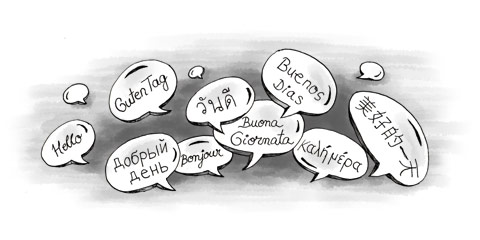In addition, several states in India have their own official languages, which are usually only spoken particular areas. Among them are Bengali (83 million speakers), Telugu (spoken by 74 million people) and Marathi (72 million speakers). However, standard Hindi, which is based on a colloquial dialect around Delhi, is taught at all schools in India.
Languages in North India
Hindi is spoken in north and central India. However, there are many dialects in India and Hindi is more like a rubric for different dialects. Whether a regional variation is considered Hindi or a dialect depends solely on social perceptions and not on mutual intelligibility.
As a rule, the further the distance between regions in India using Hindi, the harder it will be for speakers to understand each other. The relationships between dialects far away from each other are probably roughly proportional to the relationships of Latin-derived languages, such as French, Spanish and Portuguese.
Languages in South India
In the south of India there is a greater diversity of languages and you will have difficulties getting along with Hindi. Languages differ even between the important industrial centers Bangalore, Madras and Hyderabad.
English proves to be helpful here. However, you may have problems understanding Indian English (Hinglish) as there are peculiarities in grammar and vocabulary. So if someone in India says he passed out of school it doesn't mean that it knocked him unconscious, just that he finished successfully.
The main languages in South India are Malayalam, Tamil, Telugu and Kannada. They are all Dravidian languages and, therefore, share structural aspects. Much of the vocabulary was borrowed from languages such as Hindi, so there are often only different pronunciations and slight shifts in meaning.
Indian alphabet
Hindi and many Indian languages use the Devanagari alphabet, which was originally used to write Sanskrit. It is written from left to right and can be easily identified by a horizontal bar at the top of each letter. Each letter resembles a single consonant or vowel.
To being able to read languages using Devanagari without having to know their letters, there is the International Alphabet of Sanskrit Transliteration (IAST). Each Devanagari letter is resembled by a Roman character which sounds, more or less, equal to its Devanagari equivalent.
Urdu vs. Hindi
You will also meet people in the north of India saying they speak Urdu. However, Hindi and Urdu are basically the same language. The only main difference is that Hindi uses the Sanskrit-based Devanagari script in contrast to the Perso-Arabic script of Urdu. The vocabulary of both languages is essentially the same. If there is no word for a concept, both will borrow words from either Sanskrit or Persian, respectively. However, speakers of Urdu and Hindi will not encounter communication difficulties in everyday conversations.
Hinglish
As the name indicates, Hinglish is basically English, but with traces of Hindi. Indian English is derived from British English, though it includes some elements of American English.
The main difference between British English and Hinglish is its pronunciation. You will certainly have difficulties understanding Indian English in the beginning, as its pronunciation is strongly influenced by Hindi. Indians tend to stress the pre-last syllables of words, so words as liquidity will be pronounced li-qui-DI-ty, instead of li-QUI-di-ty.
Indians also have a hard time pronouncing w and v as distinct letters. Words such as weather and volleyball will be pronounced using one and the same sound somewhere in the middle between w and v.
The probably most uncommon construction in Indian English concerns the use of only. It is used to express limitation, just as in British English, but can also be used to emphasize a phrase. An expression such as “Ask him, he is from here only” would be translated to British English as: “Ask him because he was born here and knows what to do”. In this case, only refers to the entire phrase and stresses its meaning.
Another peculiarity in Hinglish is the way of referring to small or insufficient amounts of something. Your waiter at a restaurant may ask you “Was your lunch enough, or less?”. By that, he means whether you have had enough food or not. Although this use of less needs some time to get used to it should be easily comprehensible.
A typical example of how Hindi influences Indian English is the way of using the personal pronoun you in plural. Since singular and plural form are identical, Indians have simply adapted the Hindi construction referring to a group of people saying you people (तुम लोग in Hindi, pronounced /t̪um loɡ/). You will often hear this expression when there is a need of distinguishing different groups of people, such as foreigners and Indians. Nevertheless, this expression is not meant to be an offense but simply a Hindi concept translated into English.
There are far more differences between Indian English and British English than stated here, but most of them are fairly self-explanatory. For example, since family bonds are very important to Indians you will hear word constructions, such as cousin-brother and cousin-sister. These are used when referring to male or female cousins simply adding gender information through brother and sister.
There are also minor changes when it comes to words that are strictly plural words in British English. Indians might say “We need more cattles”, pluralizing a word that is already considered plural. On the other hand, words, such as scissors, might be singularized. “I need a scissor” is a perfectly acceptable sentence in Hinglish.
Hindi is not the only factor that has influenced the development of Hinglish. Even though Indians put high value on politesse, many requests, suggestions and advice will be very direct. It is common in India to express urgent requests by repeating a catch word. If you are waiting for your drink order in a restaurant, for example, and you haven't gotten it even after politely asking the waiter, you may walk up to him and say drinks drinks. This will remind the waiter of your order and is not considered rude in India.
Suggestions are usually expressed without using the subjunctive, as is common in British English. Whenever you ask Indians for help, you may be told “You do like this”, instead of “You could try to...”.
While you may be tempted to dismiss Hinglish as little more than an underdeveloped (and less polite) mish-mash of Hindi and English, you might be better off considering it an emerging English dialect. Because of Hinglish, India now boasts more English-speakers than any other country in the world, including the United States!



